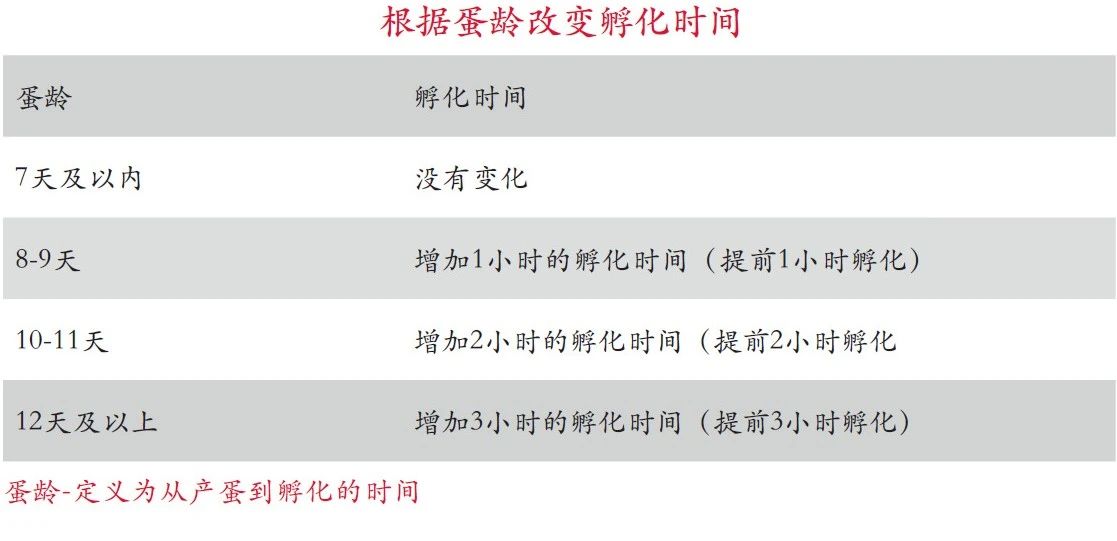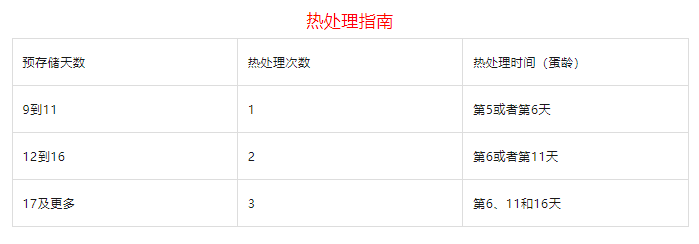Effects of seed egg storage
atchability of eggs stored between 3 and 6 days. The eggs have just been produced, and the pH of the protein is too low, which is not conducive to the development of the embryo, but can protect the embryo from bacterial infection. During storage, carbon dioxide (CO2) is released and the pH of the protein increases from 7.6 to 8.8 to 9.2(a good range). Therefore, eggs hatched within 48 hours of laying can reduce hatching rates by 1-2%. Storing eggs for a long time can also reduce the hatching rate. After 6 days of egg production, the effect increases with the increase of storage time, with a loss of 0.5% per day after 10 days and a loss of 1.0-1.5% per day thereafter. Eggs stored for a long time can affect the quality of chicks and thus reduce the weight of broilers.
Prolonged storage of the eggs (8 days or more) leads to protein degradation, which can result in the embryo being close to the shell. Early embryo death can be caused by dehydration in the early stages of incubation. In this case, turning eggs that have been stored for a longer period of time may help prevent a loss of hatchability.
The adverse effects of long-term storage are more pronounced for eggs from older week-old flocks (greater than 55 weeks of age), because these eggs have thinner shells, lower protein mass at egg production, and higher protein degradation rates during storage.
During storage, gas exchange takes place through small holes in the eggshell. Carbon dioxide diffused from the egg and rapidly decreased in concentration within the first 12 hours after laying, resulting in a decrease in protein viscosity. Eggs also lose water vapor during storage. The loss of CO2 and water during storage resulted in a decrease in egg hatchability and chick quality.
Storage conditions must be designed to minimize hatchability losses. Most seed eggs are placed in open egg bins or farm egg holders, but some are placed in LIDS. Eggs should be allowed to cool and dry as soon as possible before they are packaged to prevent condensation and subsequent microbial growth.
Storage prolongs incubation time. At the beginning of the incubation cycle, the incubation time should be increased.

Heat-treated seed eggs蛋
The loss of performance in hatcheries is often due to egg age, especially for the operation of breeding progenitor and parent generation flocks. For conventional operations, the ideal egg age is less than 7 days, but increasing storage time is inevitable as orders, yields from farms of different sizes, markets, or seasonal conditions change. Prolonging the shelf life of the eggs decreases hatching rate and chick quality, and increases incubation time and death rate at 7 days of age.
Eggs stored for more than seven days tend to develop more slowly during hatching. There was also a strong correlation between early embryo death and increased storage time. Heat treatment of seed eggs includes the use of a short period of incubation during storage. Heat treatment promotes cell division and short embryonic development. After heat treatment, there is no need to add incubation time to the specified incubation time.In practice, heat treatment results in:
Increase hatching rate
Reduce the loss of fertilized eggs during storage
Improve the quality of chicks
Shorten out the chick windowOther ways to reduce the negative effects of extended storage time:
Reduce the storage temperature. Do not go below 15°C(59°F)
Store eggs with small heads up (remember to turn them back up before hatching)
Turn eggs during storage
Increase incubation time


If you do three heat treatments, reduce the last heat treatment time to 4 hours.
The total time that the embryo temperature exceeds 32°C(90°F) cannot exceed 13 hours (eggshell temperature, not air temperature). If the heat treatment step is too long, embryo loss can occur.
After heating treatment, the egg temperature must be lowered to below 26°C(79°F) as soon as possible.
Return the heat-treated eggs to the breeding room in a place that will not raise the temperature of other eggs in the room.
After heat treatment, the eggs must be stored for at least 24 hours before hatching. If the temperature of the eggs rises rapidly during storage, condensation can occur.
Eggs should not be pushed back into the egg bank until the heat treated egg temperature is 2 degrees Celsius above the storage temperature of the egg bank.






